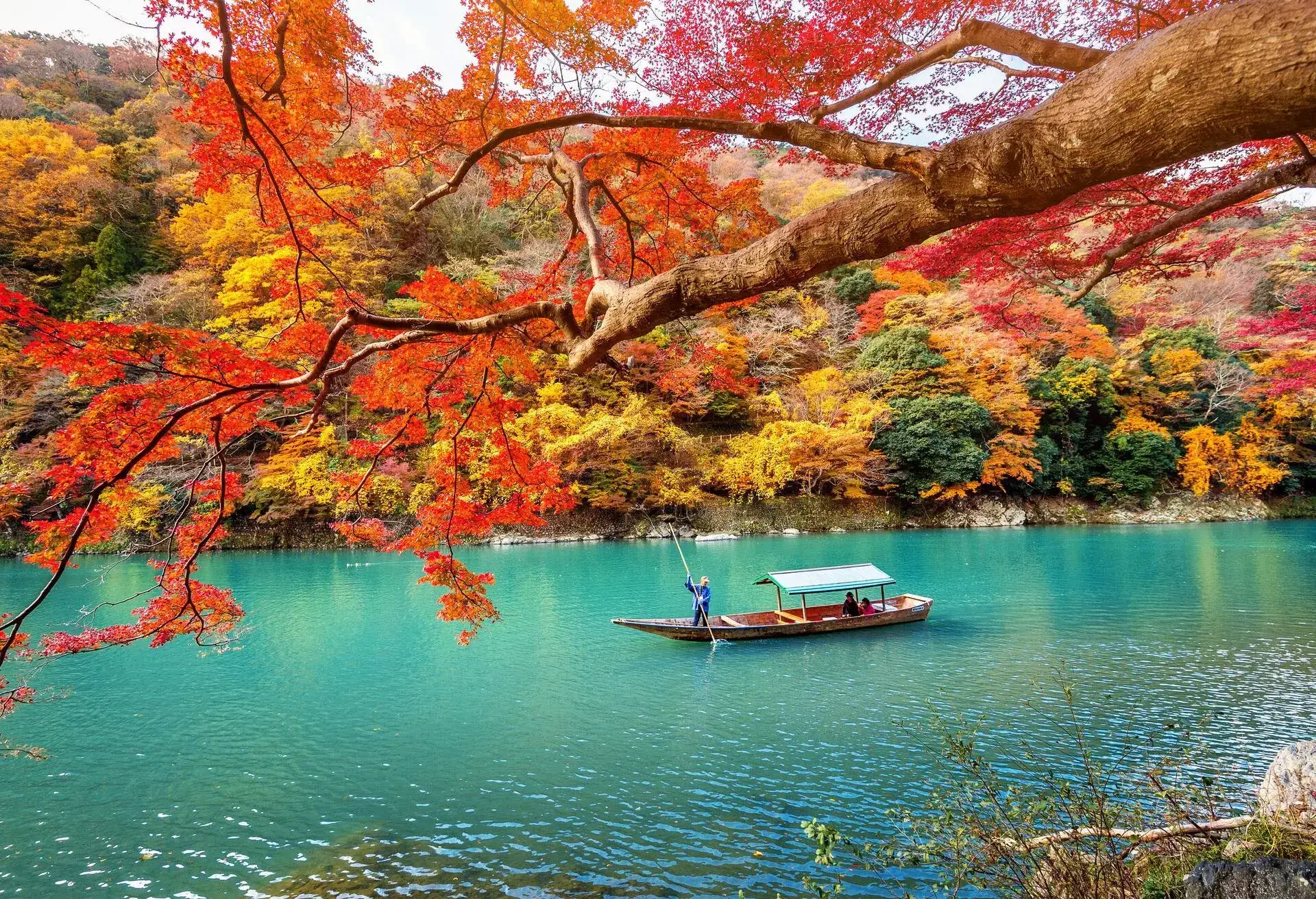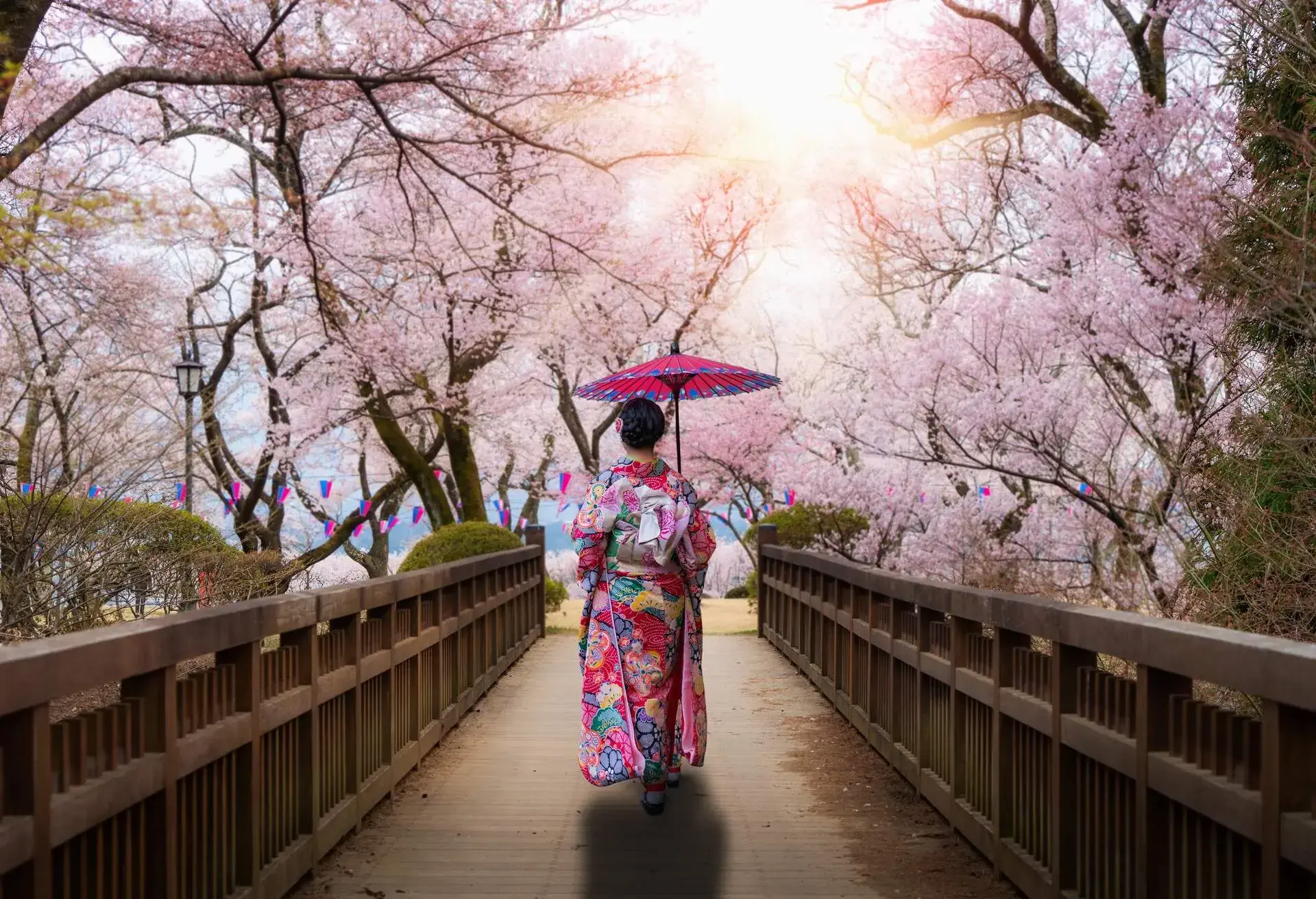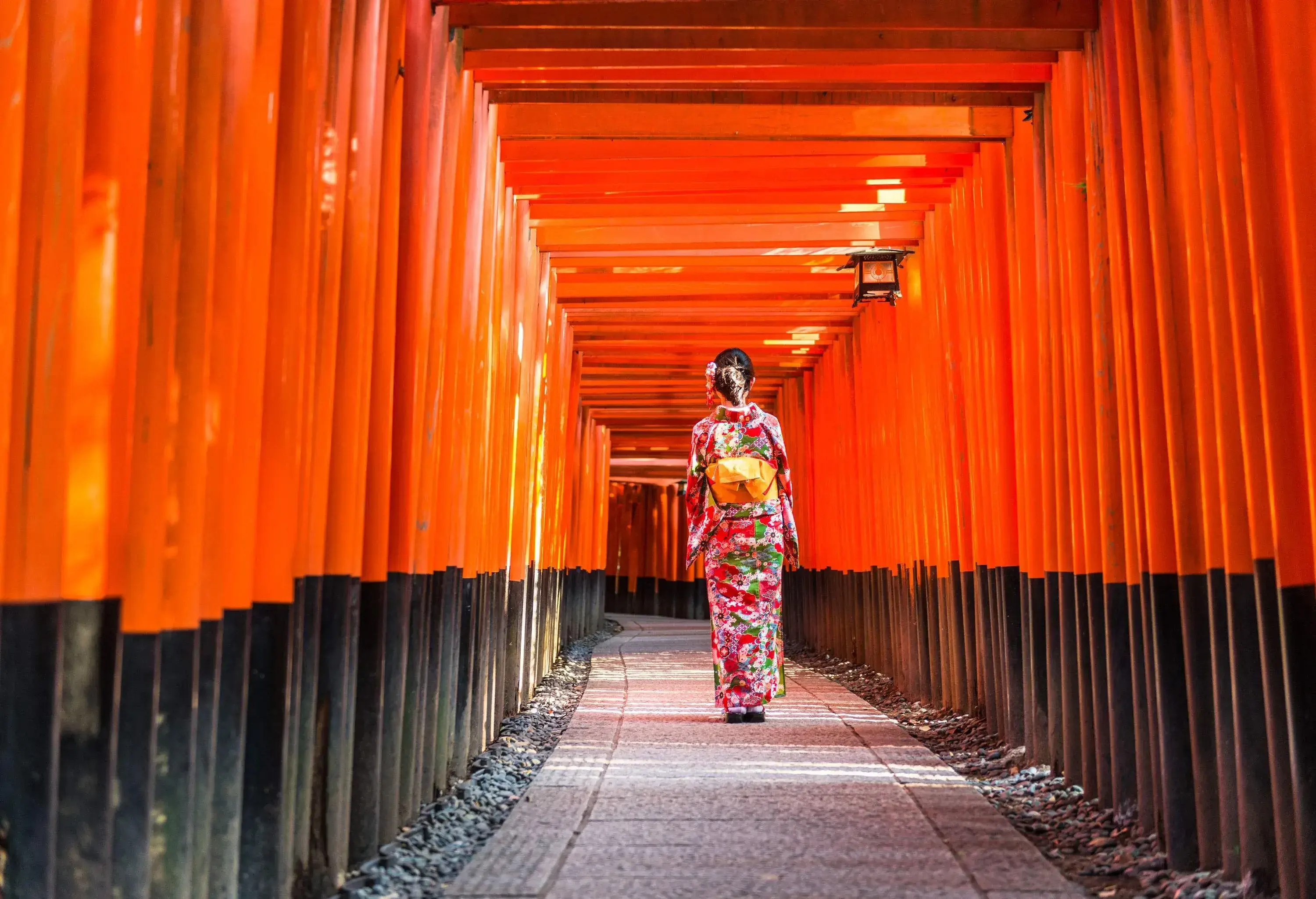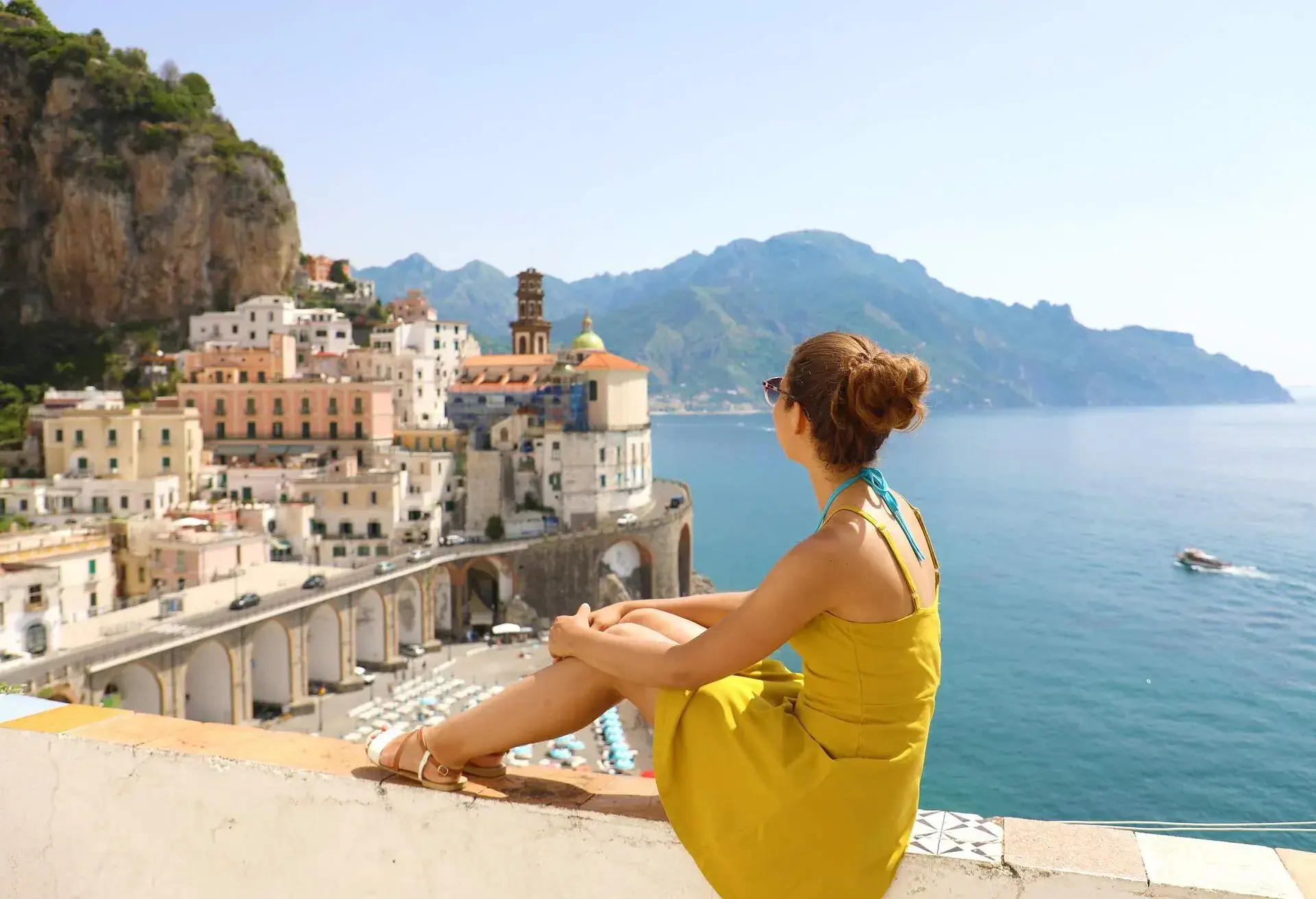Japan is full of stunning scenery and awe-inspiring attractions, many of which are in or near the most popular cities for tourists to visit. If you’re starting your planning from scratch, be sure to check out KAYAK’s guide to the best places to visit and this article on fun facts about Japan to get fully prepared. Whether you plan on visiting the winter wonderlands up north or the tropical islands to the south, you’ll find an abundance of scenic sites to visit. From shrines that date back hundreds of years to the famous floral blooms in spring, the most beautiful places in Japan are worth seeing for yourself.
Beautiful places in Japan: Meguro River, Tokyo
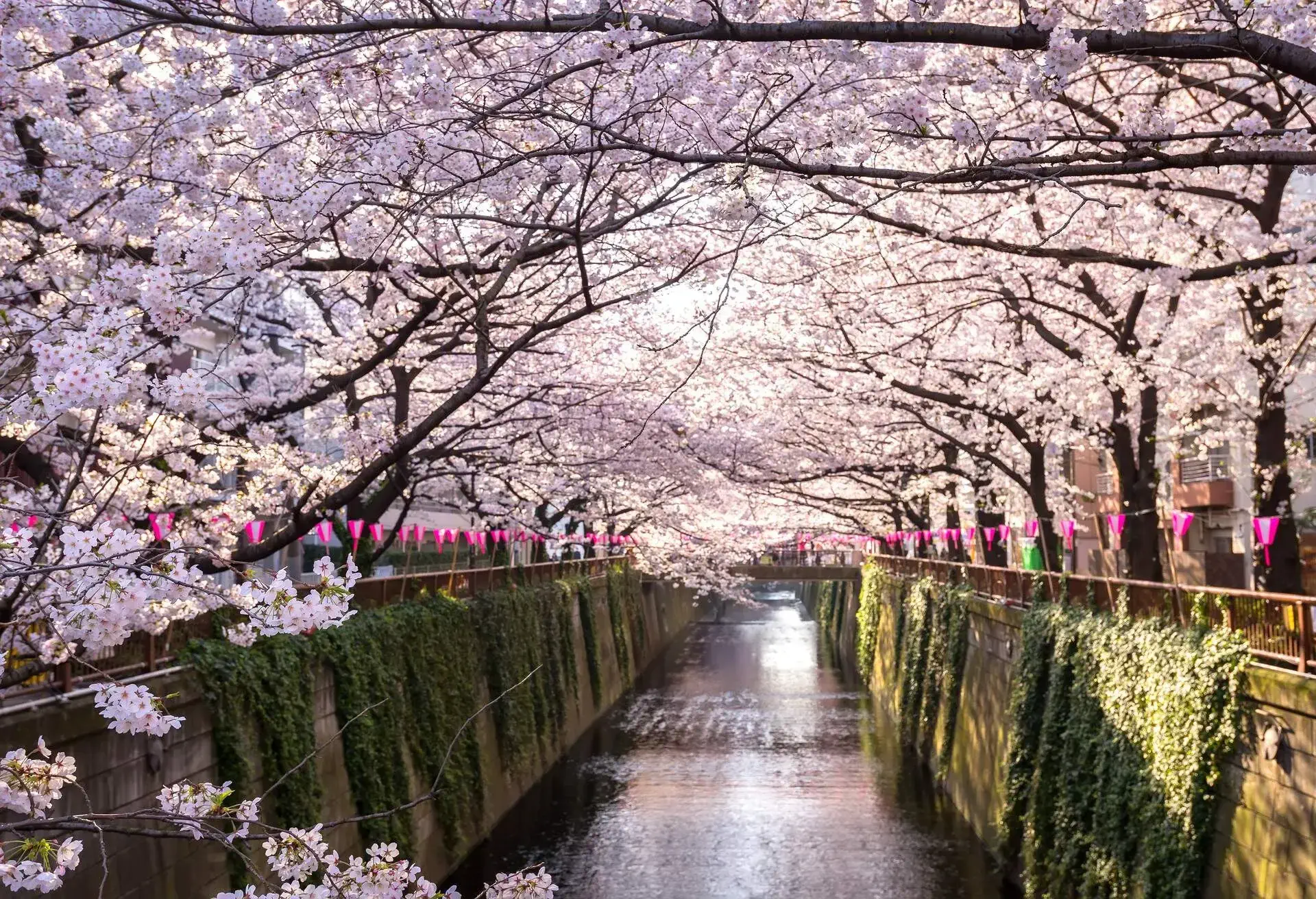
Along the banks of the Meguro River, you’ll find some of the most peaceful places in Tokyo. Except, perhaps, during the cherry blossom season, as it is one of the top cherry blossom sites in the city. But whether or not the blossoms are in bloom, you can easily spend an afternoon strolling along the river, through laid-back neighbourhoods and past cosy cafes and restaurants. The river eventually reaches Tokyo Bay and Tennozu Isle, a gorgeous sight in its own right with unique art galleries and museums.
Imperial Palace, Tokyo
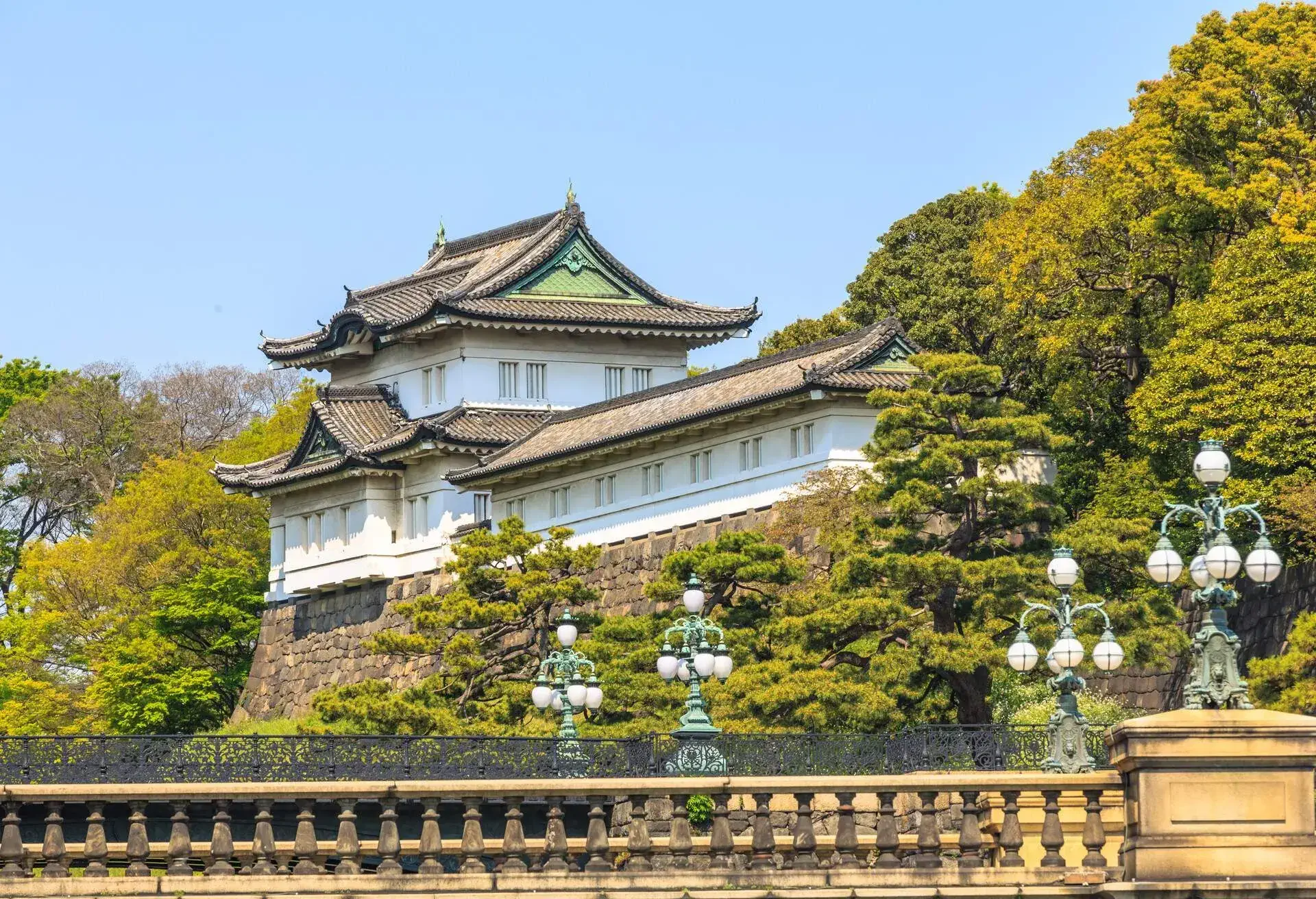
Protected by stone walls and wide moats, the current residence of Japan’s Imperial Family was first constructed in 1888 on the site of Edo Castle, which was once the seat of the Tokugawa Shogun. There is a plaza outside the palace, Kokyo Gaien, where you can get a glimpse of the beautifully landscaped palace grounds and the Nijubashi stone bridges at the entrance. The inner grounds are only fully open twice a year: January 2nd and February 23rd, when the Imperial Family makes public appearances. The rest of the year you can take guided tours of the palace grounds, between 10 am and 1:30 pm, Tuesday through Saturday.
Where to stay in Tokyo
You’ll find a wide range of hotels in Tokyo, with options to suit different budgets. For a touch of luxury, the Prince Park Tokyo Tower is a five-star hotel that offers rooms with direct views of Tokyo Tower, while Ueno Station Hostel Oriental 1 is a great budget-friendly capsule hotel that has a hot spring. For a mid-range price, Agora Place Asakusa provides simple, comfortable rooms close to Senso-ji Temple and Ueno Park.
Mount Fuji
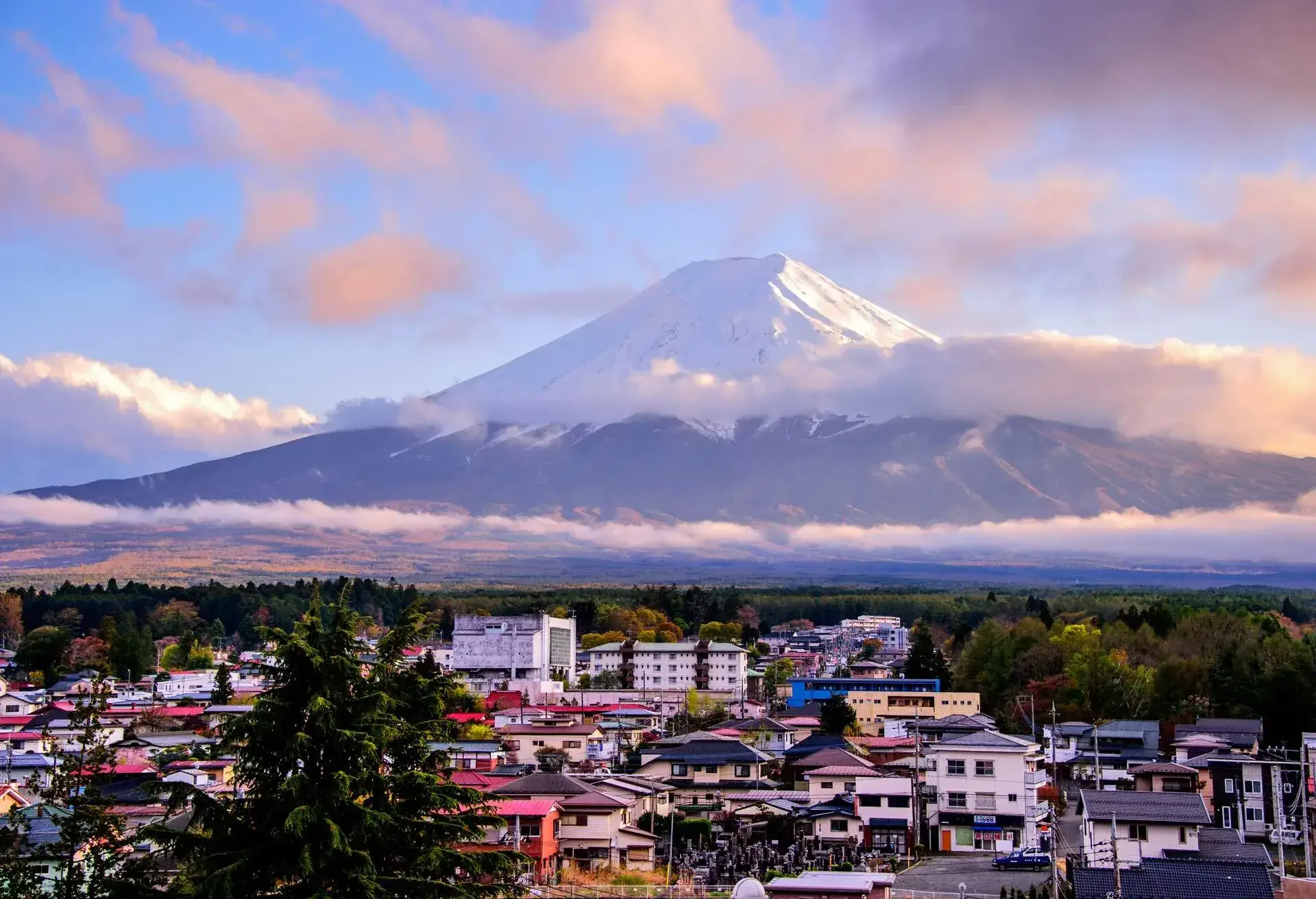
One of the most popular day trips from Tokyo, Mount Fuji is probably the most iconic natural feature of Japan. Looming over the landscape at a height of roughly 3,776 metres, Mount Fuji is still an active volcano (although, it hasn’t erupted since 1707). Visitors can climb the mountain between July and September and stay in small mountain huts along the way.
Making the climb will let you see incredible views of the surrounding region, and if you time your ascent right, you can watch the sunrise from the summit. If you’re taking the bullet train from Tokyo to Osaka on a clear day, you can get a great look at the mountain from the right side of the train, about 45min after departure.
Fuji Five Lakes Area
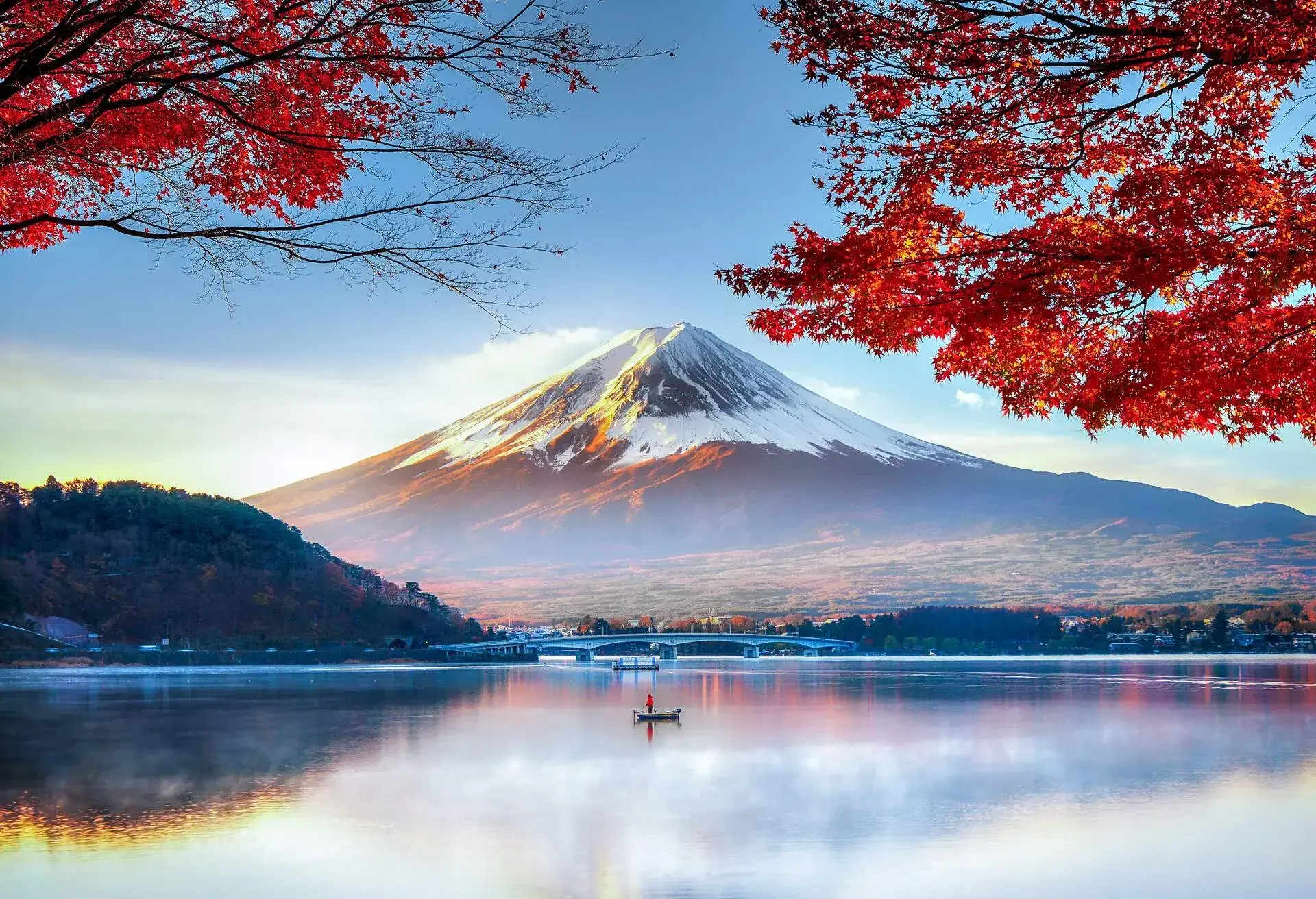
The Fuji Five Lakes Area is one of the most beautiful places in Japan, offering gorgeous views from the northern base of the mountain. The five lakes (Kawaguchiko, Yamanakako, Saiko, Shojiko and Motosuko) formed hundreds of years ago as a result of eruptions from the mountain. All of the lakes are breathtaking and have spots where you can get a perfect view of Mount Fuji. Lake Kawaguchiko is the most developed and Kawaguchiko town is the gateway to the region. Lake Motosuko is the most untouched, with a few campgrounds nestled in stunning natural scenery.
Where to stay near Mount Fuji and the Fuji Five Lakes Area
Many travellers visit Mount Fuji and Five Lakes Area as a day trip from Tokyo, but if you love outdoor activities, it’s worth staying a night or two. Kawaguchiko Lake is surrounded by hotels and ryokans on its eastern shore. You can stay in traditional-style rooms at the Fuji View Hotel, which lives up to its name with great views of the mountain. K’s House Mount Fuji is an excellent budget-friendly option within walking distance of Kawaguchiko Station.
Oyama Rice Terrace, Kamogawa
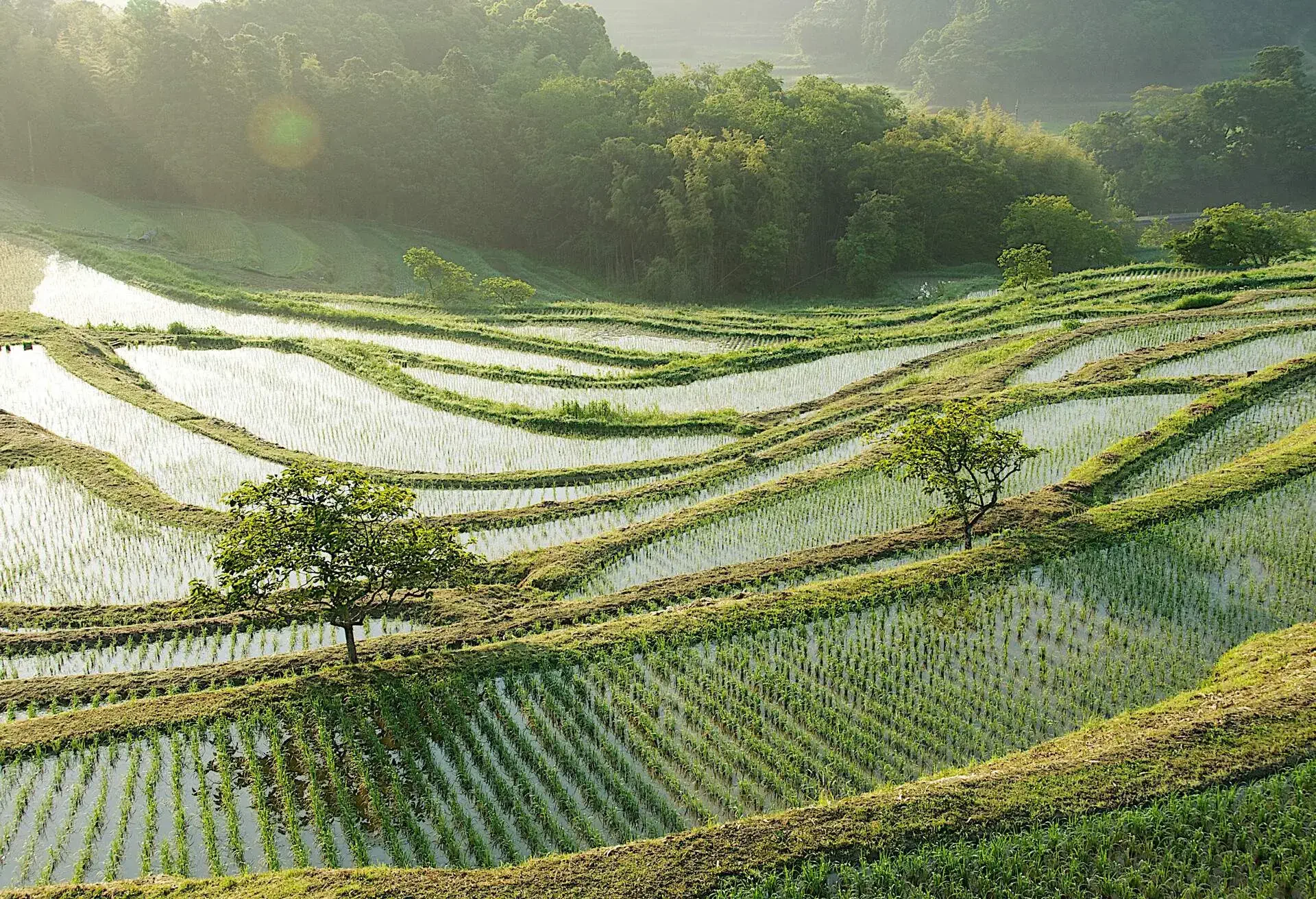
When you visit Japan, beautiful scenery is never far away, and another excellent option for a day trip from Tokyo is the gorgeous Oyama Rice Terrace. The fields date back nearly 800 years and wind in arches up the hill, creating picturesque patterns. Made up of around 375 rice paddies, this is the only rice terrace that relies solely on rain as its water source.
Arashiyama Bamboo Grove, Kyoto
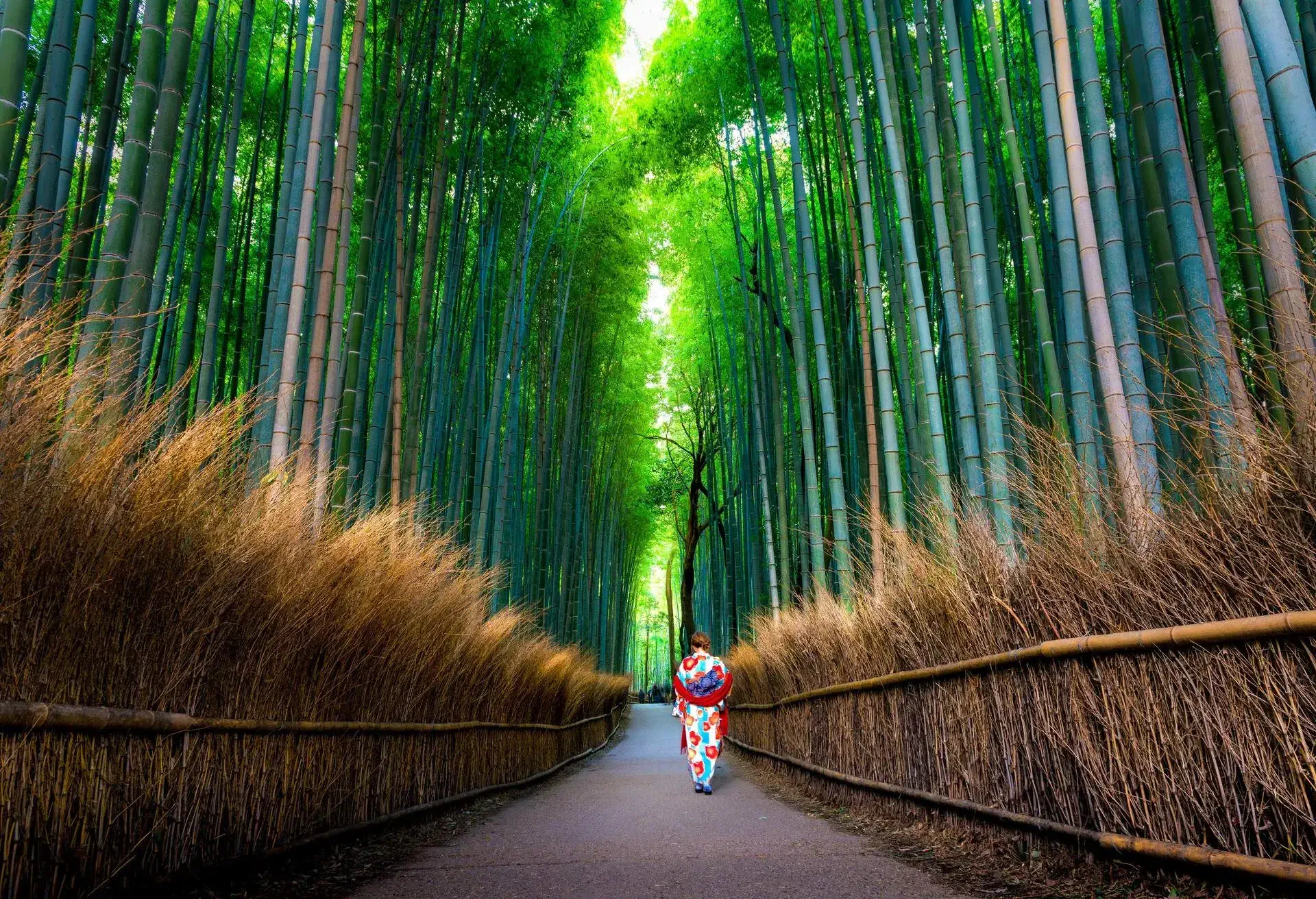
Kyoto is home to some of Japan’s most popular photo backgrounds, and the Arashiyama Bamboo Grove is no exception. In this natural bamboo forest, stalks stretch up to the sky, swaying back and forth in the wind as sunlight dapples on the paths winding through the grove. There is a single path leading through the bamboo which takes you to the Okochi-Sanso Villa. This villa was once the home of the famous actor Okochi Denjiro, and today both the gardens and the interior are open to the public.
Fushimi Inari-Taisha, Kyoto
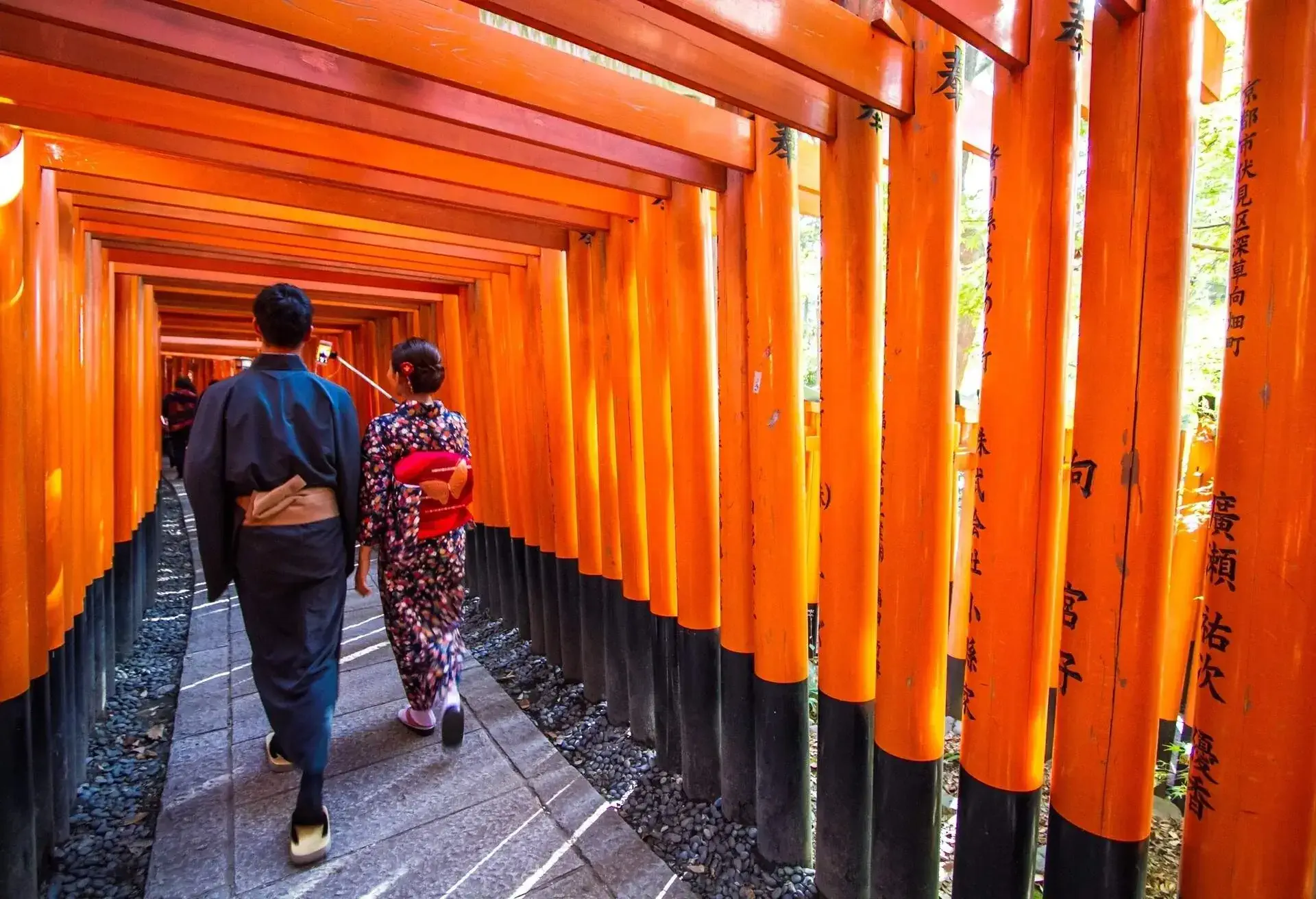
You’ll find torii gates – large red gates that mark the entrance to Shinto shrines – throughout Japan, but the torii gates of the Fushimi Inari-Taisha temple in Kyoto are probably the most famous. There are thousands of them, both leading up to the shrine and lining the pathways behind the shrine. These paths will take you into the beautiful forest of Mount Inari, which you can summit in around 3 hours, spotting many smaller shrines along the way. The shrine is best known for its exterior, but the buildings’ interiors are also beautiful; you can visit the site at any time of day for free.
Kinkaku-ji Temple, Kyoto
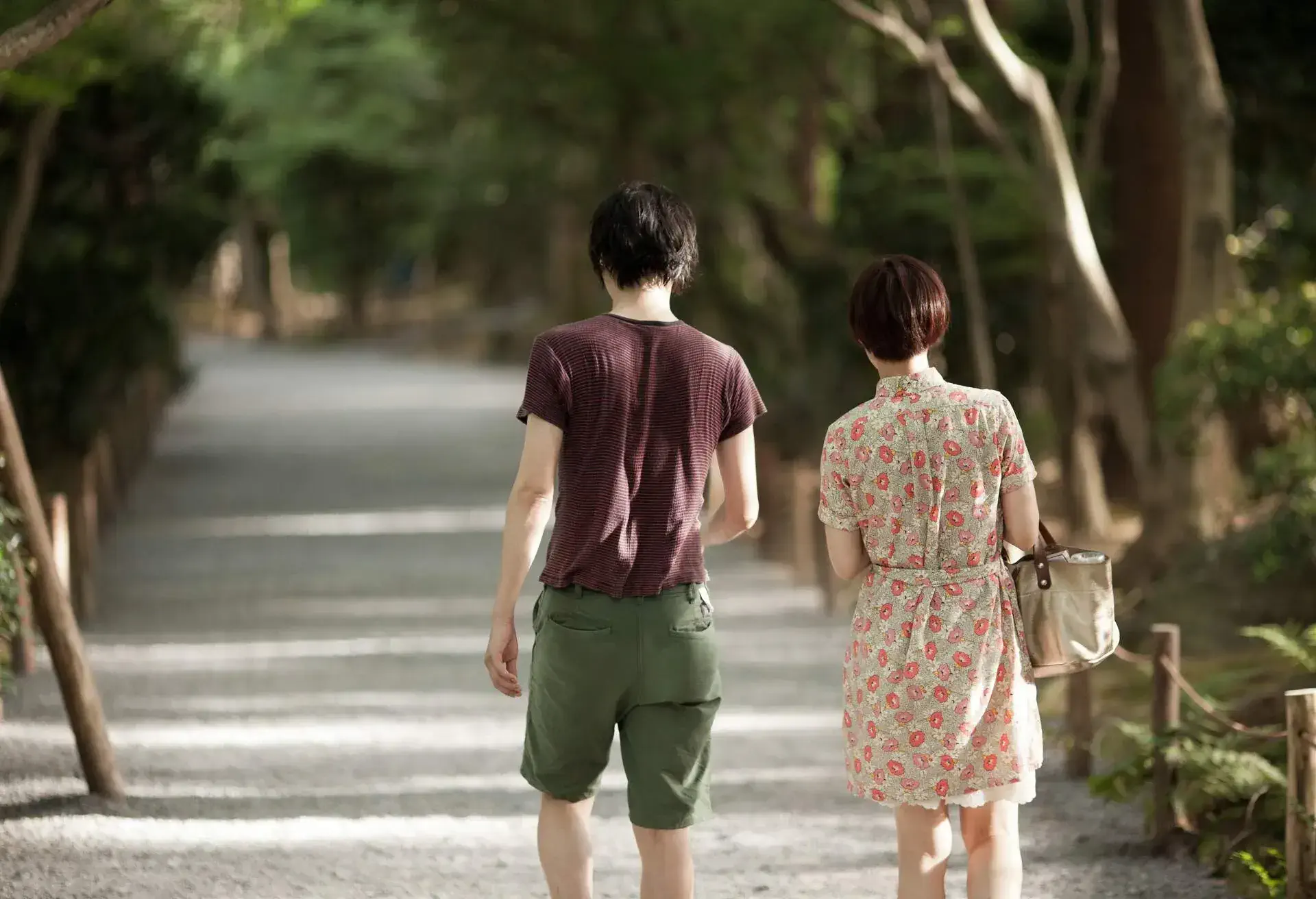
Kinkakuji, or ‘Golden Pavillion’, earns its title by completely covering its two upper floors in gold leaf that shines brilliantly on sunny days. Nestled amongst trees on the edge of a large pond in northern Kyoto, it was once the retirement villa of a famous shogun Ashikaga Takauji. After his death in 1358, it was transformed into a Zen temple. Unfortunately, visitors cannot enter the temple, but the exterior is stunning enough, with each floor echoing a different architectural style.
The first floor represents the Shinden style from the Heian period. The second floor uses the Bukke style that samurai homes used during the Kamakura period. The third and final floor is constructed to look like a Chinese Zen hall, with a striking golden phoenix set upon the roof.
Where to stay in Kyoto
Kyoto is one of the best places in Japan to get a glimpse into the country’s history, so it’s the perfect place to try out more traditional accommodations. Ryokans are traditional Japanese inns where you’ll find hot springs, traditional-style rooms and beds and communal meals made from locally sourced ingredients. The Kyoto Ryokan Kinoe is an excellent option close to Gion-shijo Station and the Yasaka Shrine.
Nara Park
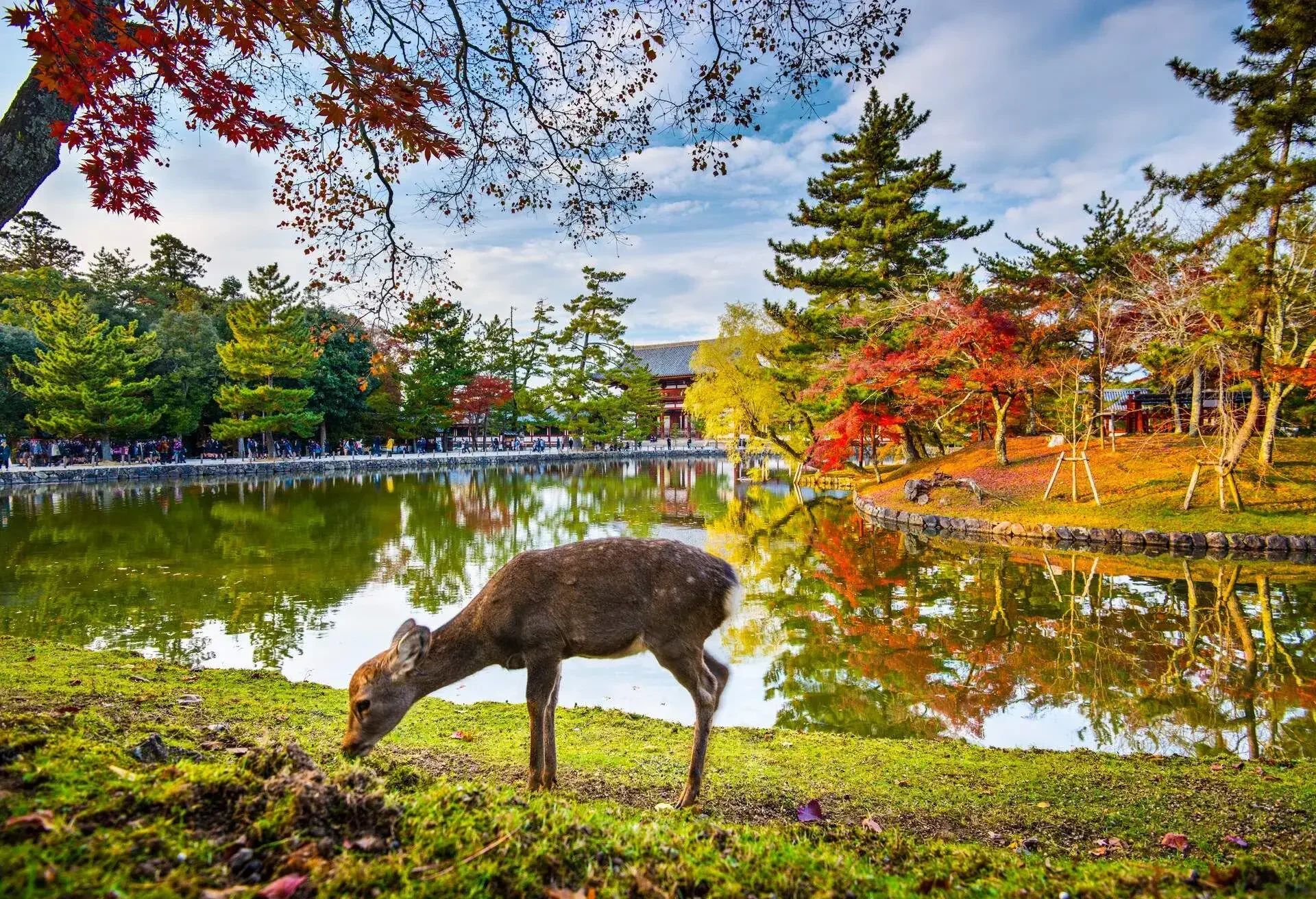
The city of Nara is around 35min away from Kyoto on the Kintetsu train line, and in the centre of the city, you’ll find Nara Park. Here, deer roam freely and are comfortable approaching visitors, particularly those with some ‘deer crackers’ in their hands. The Nara deer are a designated national treasure of Japan and the symbol of Nara city. The park itself is beautiful, with large trees, stone lanterns and some of the oldest torii gates in Japan. Nara is one of the nicest places in Japan for families, and if you’re planning a family holiday, you might like our guide to kid-friendly locations in Japan.
Itsukushima Shrine, Miyajima
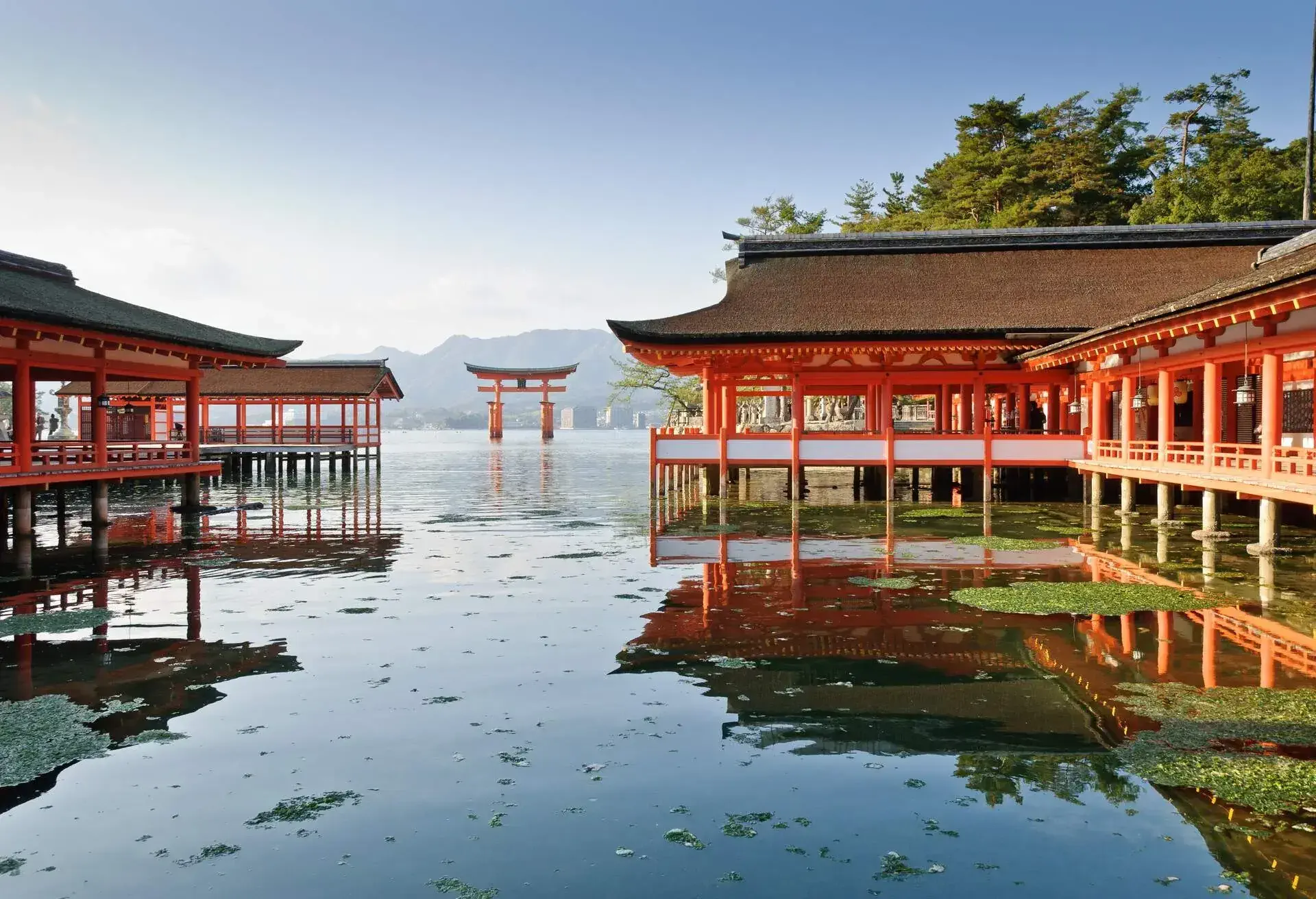
Kyoto’s Fushimi Inari-Taisha shrine is known for its thousands of torii gates, but the Itsukushima Shrine in Miyajima is famous for just one. The shrine and its lone torii gate were built over water, and at high tide, they appear to float on the water. The image of the floating gate is truly stunning, with its mirror image appearing on the water on calm days. The shrine is hundreds of years old and the buildings are connected by boardwalks that stretch over the water. You can take a boat cruise around the island and through the torii gate at high tide.
Tottori Sand Dunes
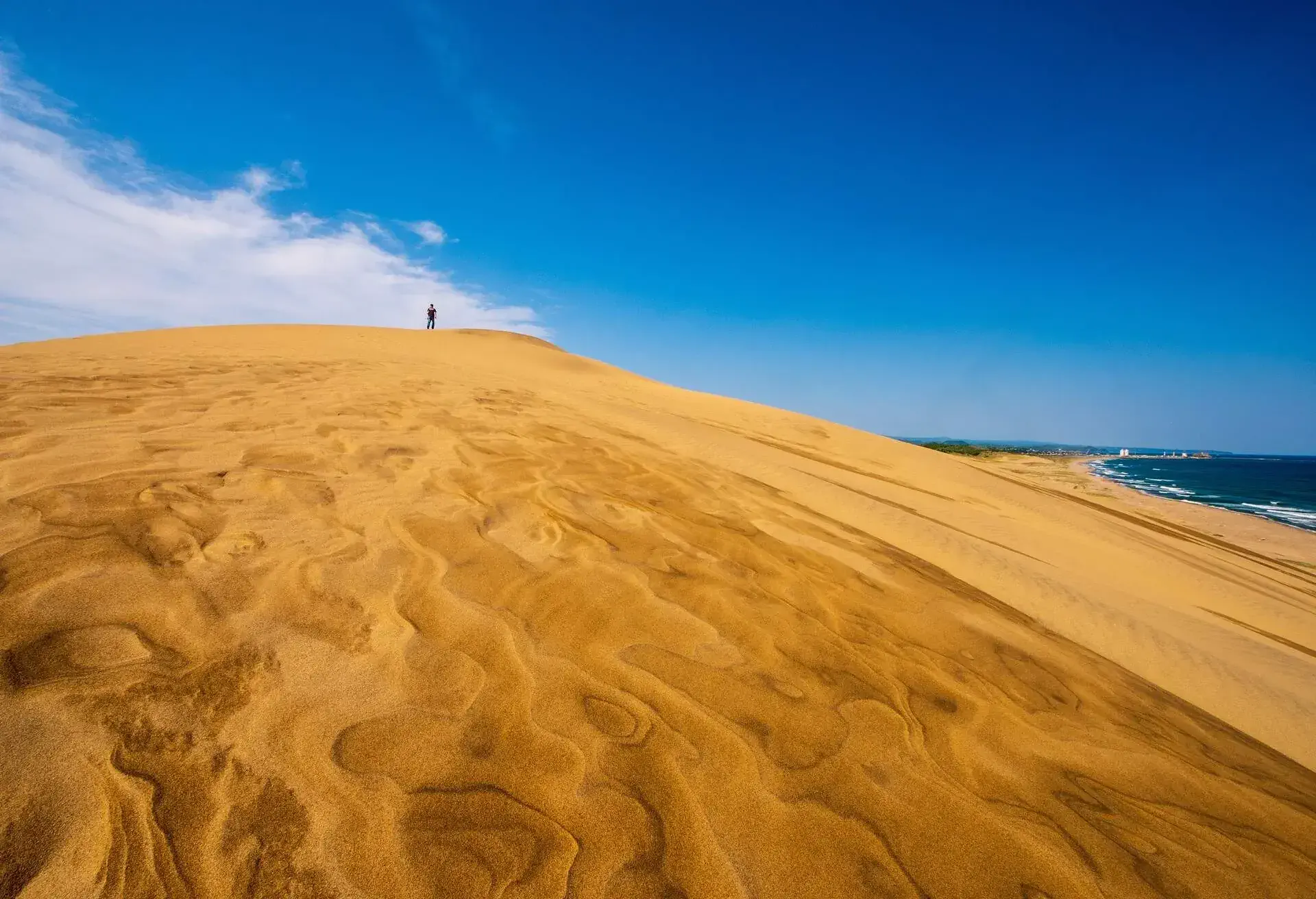
The city of Tottori is the capital of Tottori Prefecture on Japan’s western coastline, and on the outskirts of the city, you’ll find stunning sand dunes. These dunes are approximately 16 kilometres long and individual dunes can be up to 50 metres high. You can explore the dunes on foot, via camel rides or in horse-drawn carts. Sandboarding and para-gliding are also popular activities. Near the dunes, you’ll find The Sand Museum, which hosts intricate sand sculptures made by artists from around the world.
Himeji Castle, Himeji
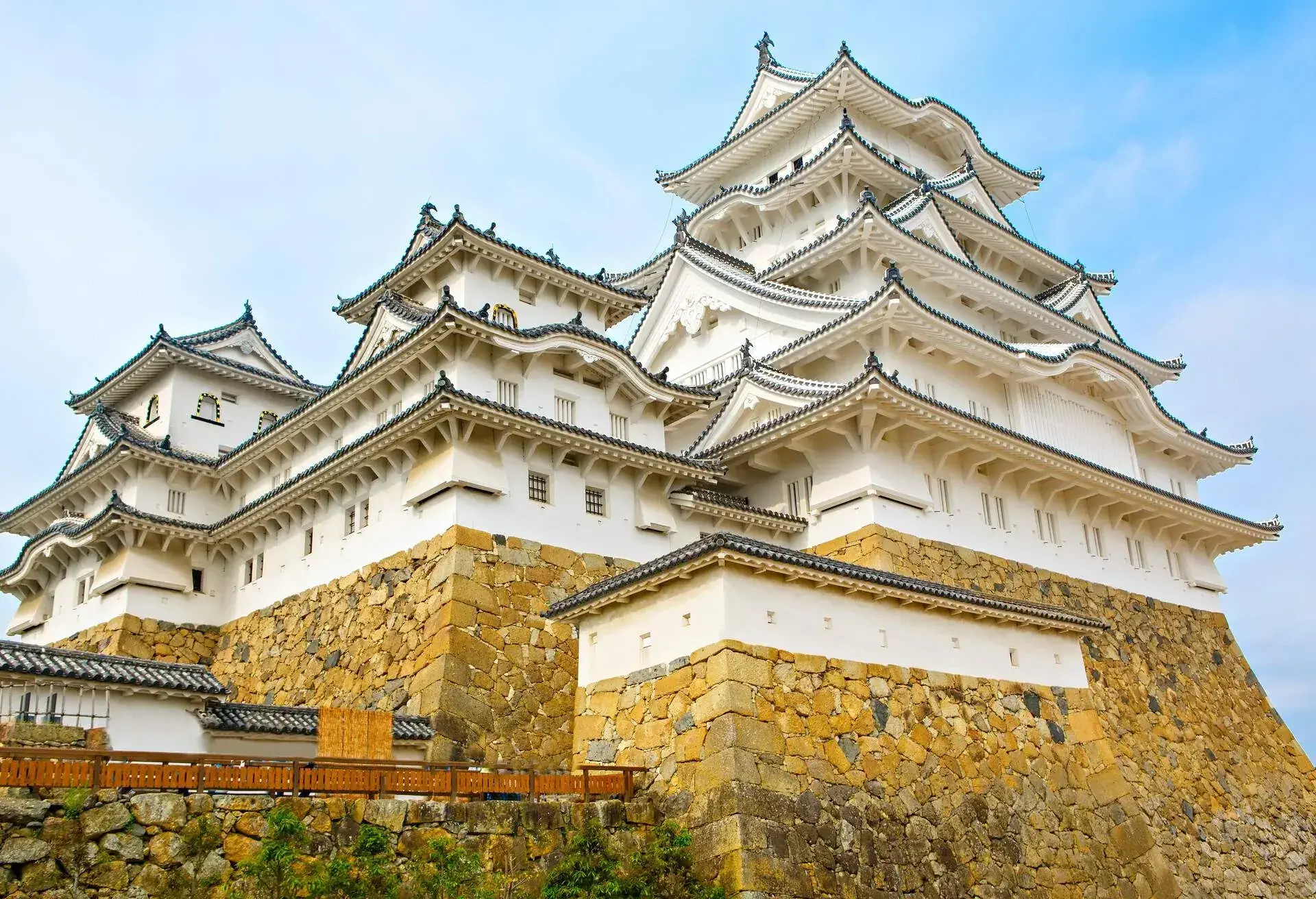
Japan’s largest (and possibly most popular) castle, Himeji Castle is known for its stunning white exterior, grand size and remarkably well-preserved interiors and grounds. Located atop a hill summit in Himeji City, many travellers visit as a day trip from Kyoto; it is roughly 45min away via bullet train. To reach the castle itself, you’ll first need to take a cable car up Mount Sosha (or make the 1-hour hike). Then you can take a bus to the entrance or make the roughly 20min walk. There’s also a temple at the top of the mountain, surrounded by beautiful statues, shrines and graves.
Where to stay in Himeji
Although you can visit Himeji as a day trip from Kyoto, you might prefer to book an overnight stay to avoid rushing to catch the bullet train back. Hotel Livemax Himeji Shiyakusyo-Mae is a great budget-friendly option that’s about 15min from Himeji Railway Station on foot. If you’d like an option with a hot spring, consider the Dormy Inn Himeji, while the Comfort Hotel Himeji is an excellent centrally located option.
Shirakawa-go and Gokayama
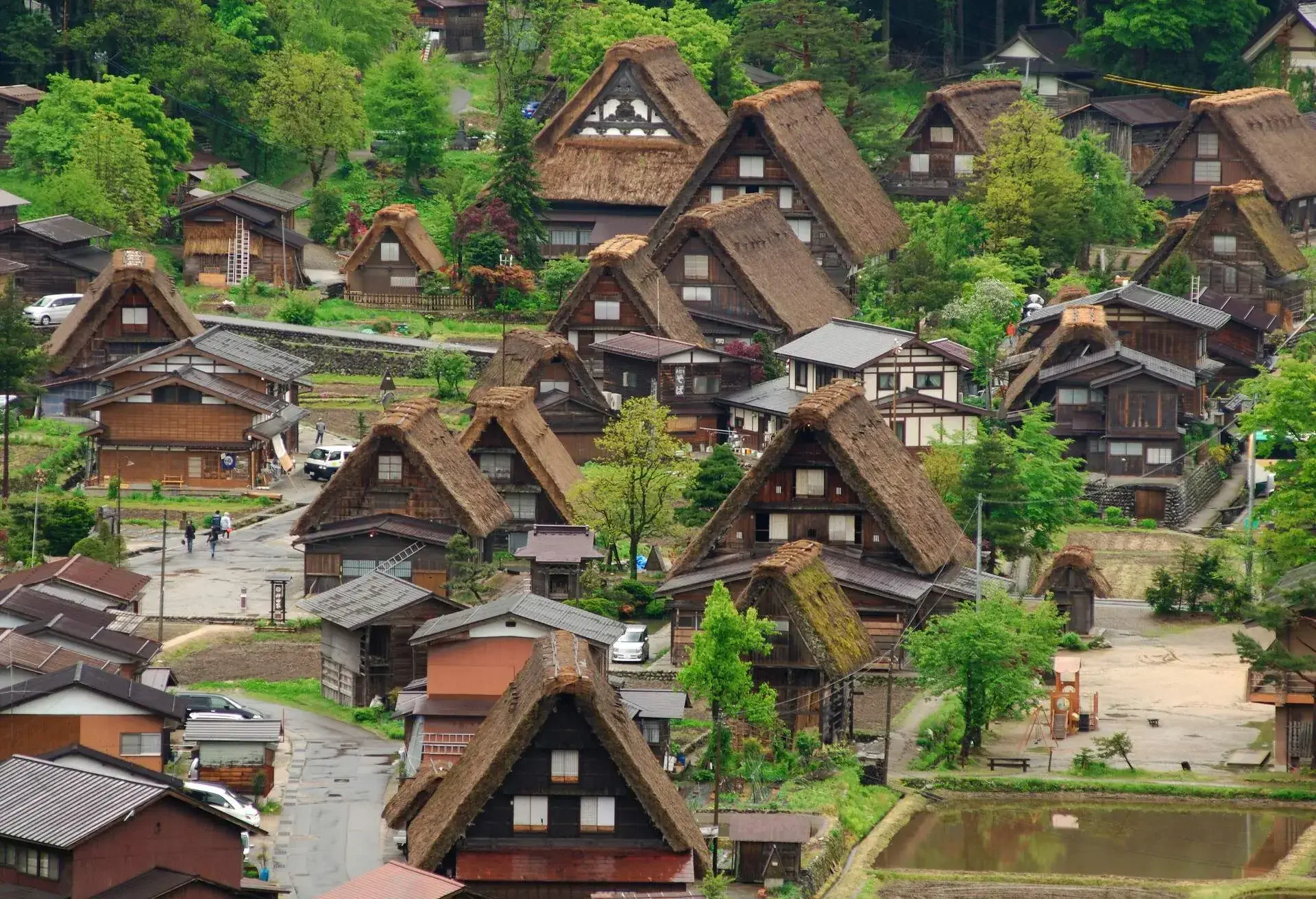
Shirakawa-go and Gokayama are neighbouring regions renowned for the traditional farmhouses that date back hundreds of years. The farmhouses were built in the gassho-zukuri architectural style, where steep rooftops resemble a Buddhist monk’s hands in prayer. These rooftops are picturesque and practical, helping the houses withstand heavy snowfall and providing large attic spaces. Shirakawa-go is the more popular of the two, and Ogimachi is its most well-known village. Ainokura is one of the most popular villages in Gokayama, and villages in this region tend to be less crowded than in Shirakawa-go.
Where to stay when visiting Shirakawa-go
Takayama and Kanazawa are the best base cities for a day trip to Shirakawa-go. The trip from Takayama takes roughly 50min by bus, and the bus departs from the Takayama Bus Terminal. The Hida Takayama Washington Hotel Plaza is a great option that’s just a few minutes’ walk from the bus terminal. In Kanazawa, you can take the bus from outside Kanazawa train station and arrive in Shirakawa-go in around 75min. There are lots of hotels around Kanazawa Station, including the Garden Hotel Kanazawa and the Via Inn Kanazawa, which is located inside the station.
Cherry Blossoms and Mount Yoshino
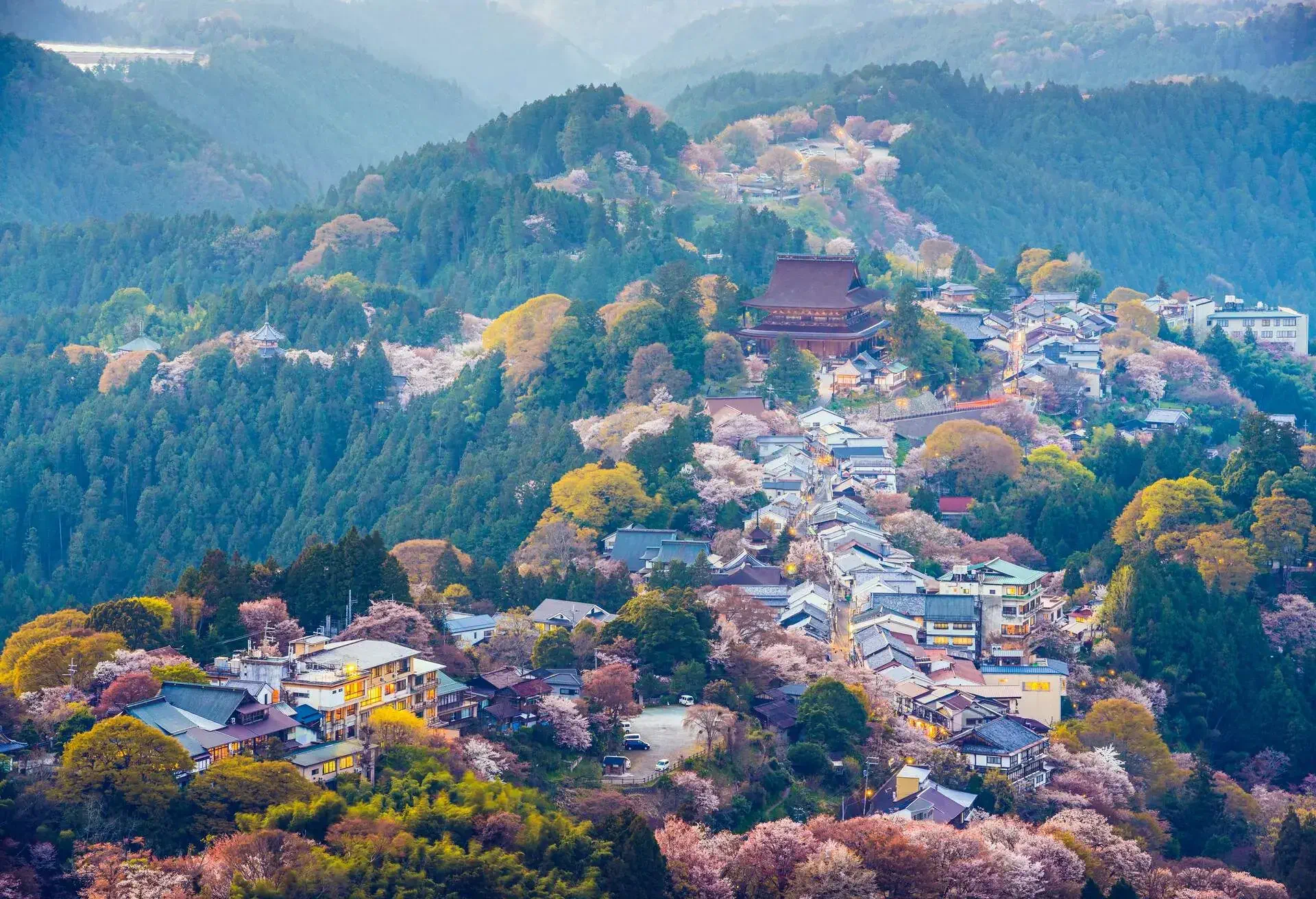
From late March to mid-April every year, visitors from around the world flock to Japan to see the country’s cherry blossoms in bloom. You can find them throughout the country, including along the streets of Tokyo, but one of the most stunning blossom locations is Mount Yoshino. Its slopes are covered in roughly 30,000 cherry trees, which are usually in full bloom between early and mid-April.
The mountain is divided into four parts. Shimo Senbon and Naka Senbon are the lowest sections, hosting the main town areas alongside the cherry trees. Kami Senbon is higher up with fewer buildings and is usually less crowded, despite the breathtaking panoramic view at Hanayagura View Point. The final section, Oku Senbon, doesn’t have as many trees as the other sections, but they bloom around one week later, so they might fit your travel plans better.
Ashikaga Flower Park, Ashikaga
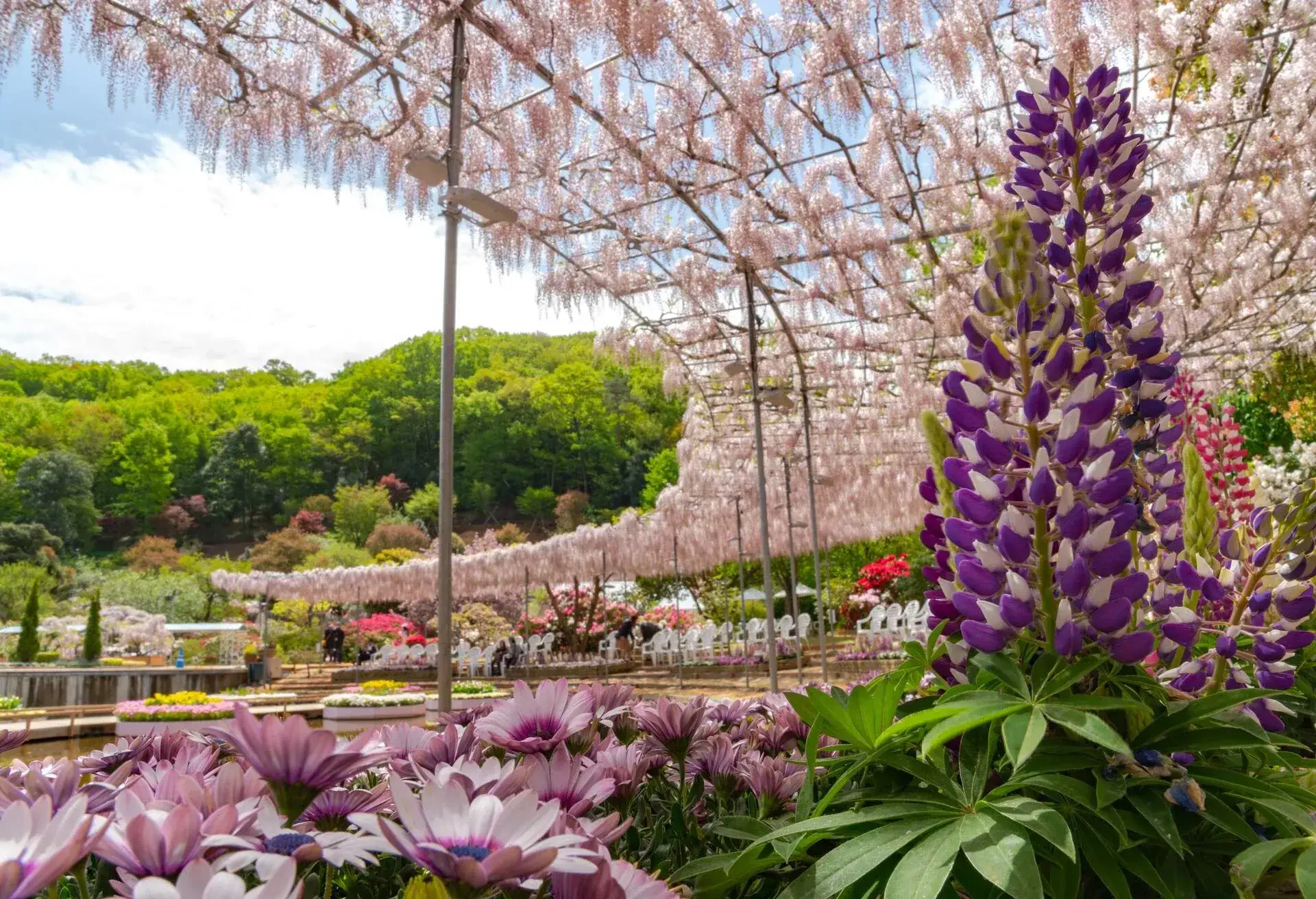
Japan’s most famous botanical sight is its cherry blossoms, but in late April and early May, wisteria blooms in gardens around Japan. The Ashikaga Flower Park in Ashikaga City, in the Tochigi Prefecture, is one of the best places in the country to see them.
There are over 350 wisteria trees in soothing shades of blue, purple, white and pink. Highlights of the park include an approximately 80-metre-long tunnel surrounded by white wisteria and a massive purple wisteria that’s over 100 years old and requires support beams to keep its branches aloft. Although early May is the best time to see the wisteria in full bloom, the park has also become a popular attraction in winter, hosting light shows at night between October and February.
Hitsujiyama Park, Chichibu
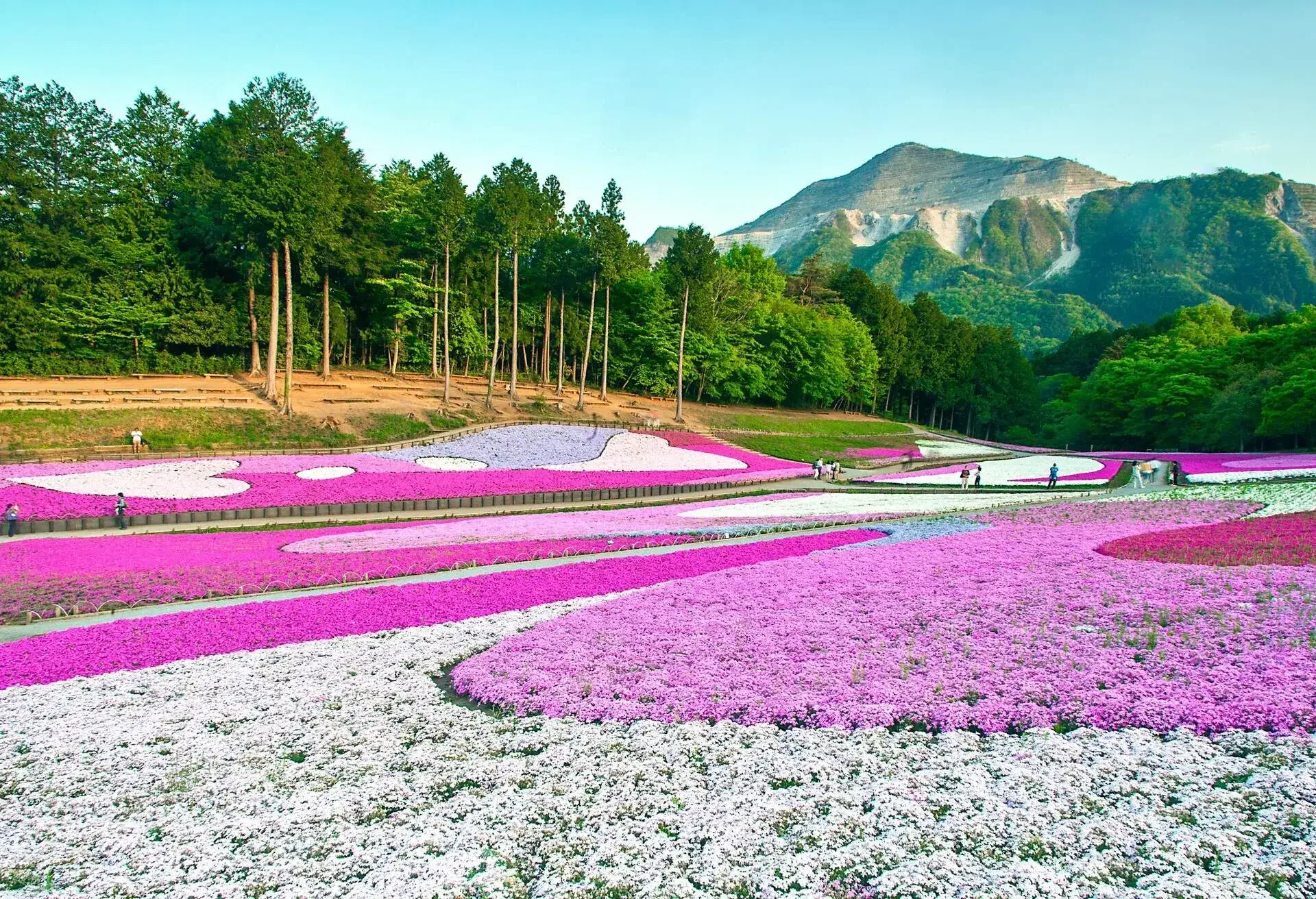
Late April and early May is the perfect time for botany lovers to be visiting Japan. Once you’ve had your fill of cherry blossoms and wisteria, head to Hitsujiyama Park in Chichibu to witness the park’s bright pink moss fields. You’ll find the Hill of Pink Moss at the southern end of the park, where around 10 varieties of pink moss, or shibazakura, grow. The park is also home to some cherry blossom trees as well as tulips and plum blossoms. If you visit during the festival that runs through the blooming period, you can pick up souvenirs (and snacks) from local vendors at the park.
Lake Kussharo, Teshikaga, Hokkaido

Lake Kussharo is the largest of Japan’s caldera lakes (lakes formed by volcanic eruptions) by surface area and is framed by forests, hot springs and campsites. In warmer weather, you can take a boating trip across the lake or swim in the cool waters.
Many travellers head to Hokkaido in winter when the lake freezes over in the middle and the surrounding hills are capped with snow. Winter is also when swans come to Lake Kussharo. Although the middle of the lake freezes over, the edges remain warm due to a nearby thermal spring, which brings swans to the area.
Shirogane Blue Pond, Biei, Hokkaido
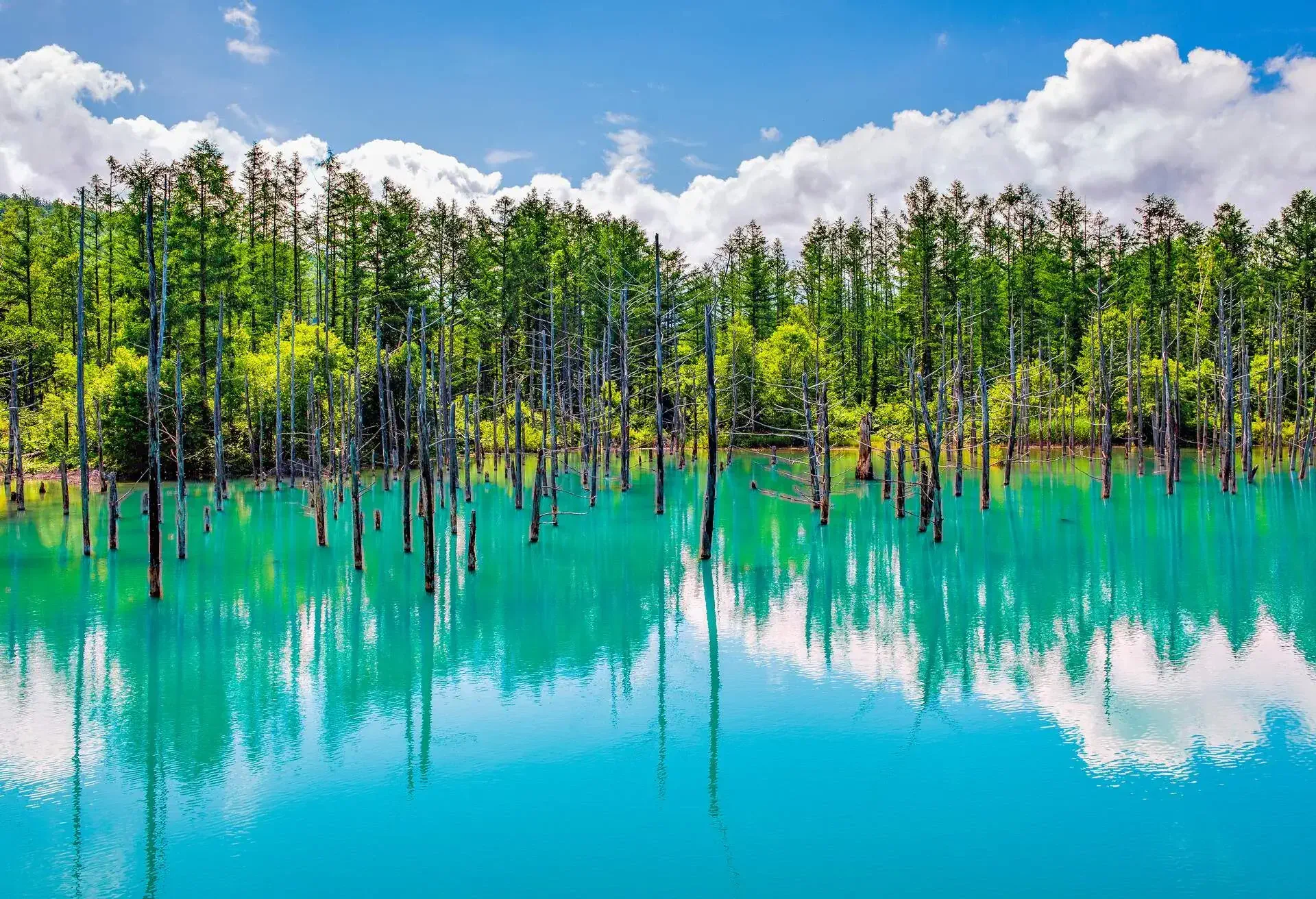
Shirogane Blue Pond is a man-made lake nestled in the forests of Biei, created as a result of dam construction on the Biei River. At the pond’s source, Shirahige Falls, water picks up aluminium from the cliffs it flows down. This aluminium disperses evenly through the water and scatters sunlight in short wavelengths that create the bright blue colour of the pond. The remarkable atmosphere of the pond is enhanced by the semi-submerged dead trees that rise up out of the blue water. Shirogane is uniquely stunning in every season: at its bluest in spring, surrounded by green trees in summer, red leaves in autumn and frozen over with an icy blue shade in winter.
Where to stay in Hokkaido
The Kussharo Prince Hotel is a great option for those who plan on visiting Lake Kussharo. It’s situated directly on the lake and is one of only a few hotels in the area. If the Shirogane Blue Pond in Biei is a higher priority, consider the Yumoto Shirogane-Onsen Hotel, which sits on the edge of the forest where you can find the Blue Pond. It’s about a 35min walk to the pond or a roughly 5min drive.
Miyako-jima, Okinawa
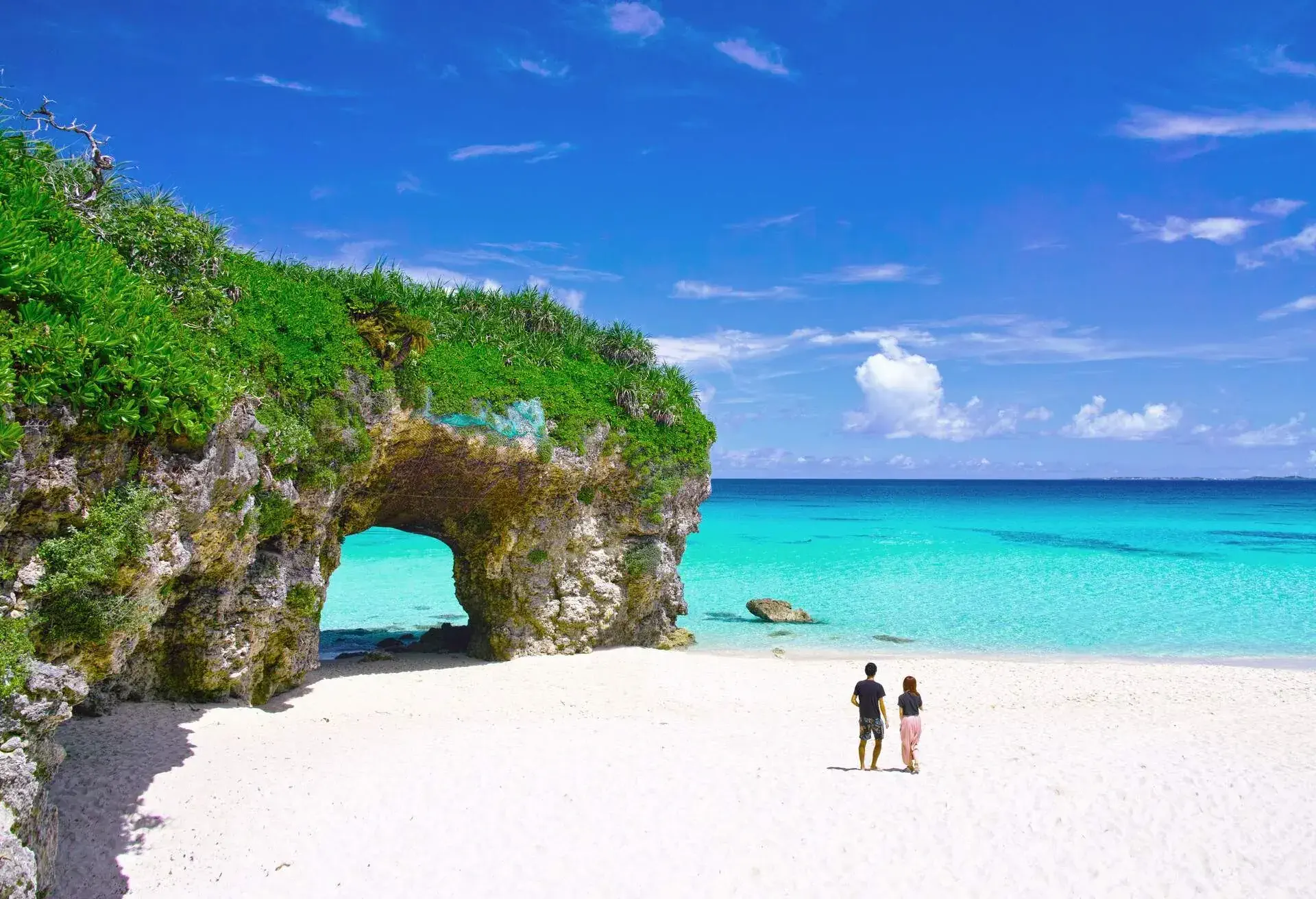
The Okinawa Prefecture is Japan’s southernmost prefecture, and most of its islands have a subtropical or tropical rainforest climate with warm temperatures throughout the year. The island of Miyako, around 300 kilometres south of Okinawa Main Island, is home to some of the best beaches and most beautiful coral reefs in Japan. Maehama Beach is made up of roughly 7 kilometres worth of warm sand, and its southwestern position provides stunning sunsets. Yoshino Beach is perfect for visitors who love snorkelling, with clear waters, brightly coloured fish and gorgeous coral.
Tuyumya Grave
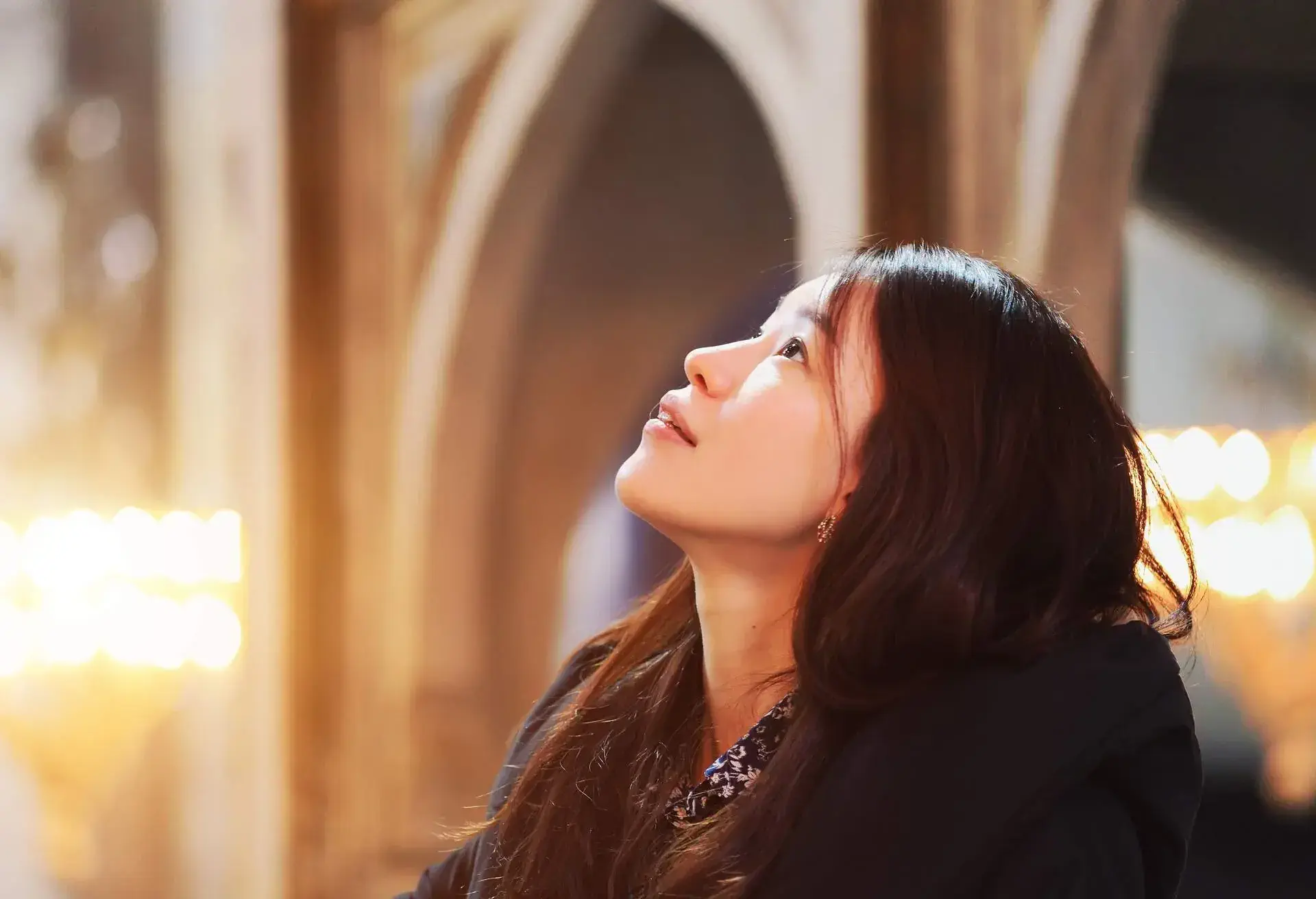
While you’re visiting Miyako-jima, be sure to take a moment to head away from the busy beaches and visit the Tuyumya Grave. The final resting place of the island’s leader in the 16th century and his descendants, it has been designated a national cultural asset. Its short, stone pillars and hinpun stone gates make it a unique site that’s well worth a visit while you’re on the island.
Ishigaki Island and the Yaeyama Islands, Okinawa
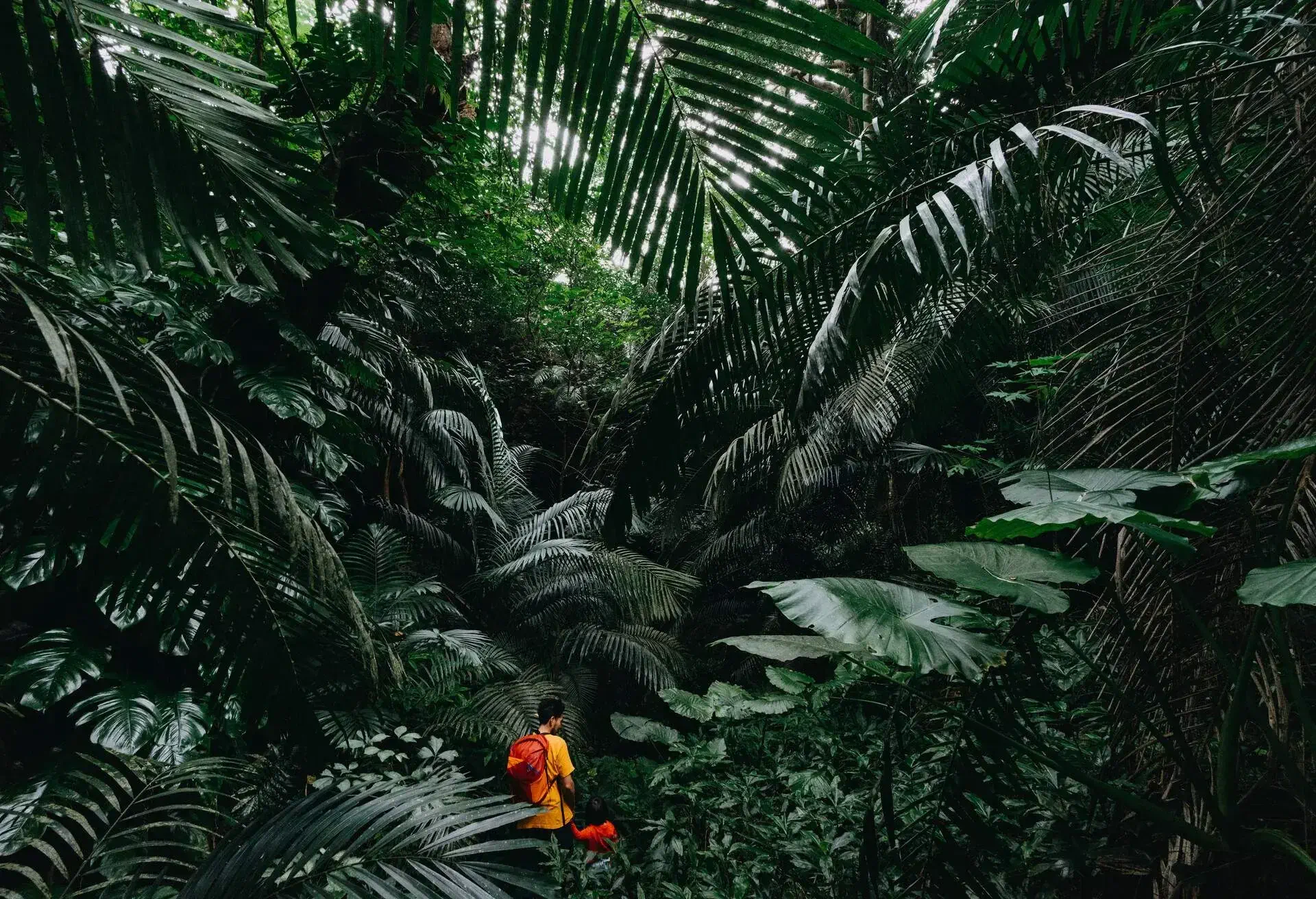
Another picturesque island in the Okinawa Prefecture is Ishigaki Island, the gateway to the remote Yaeyama Islands. One of Ishigaki’s main attractions is the Shiraho Reef, off the southeastern shore; it boasts a large collection of blue coral colonies, estimated to be around 1,000 years old.
You can see this reef, or any of the others around the island, by snorkelling, diving or taking a glass-bottom boat tour. The other Yaeyama Islands are home to beautiful sights and experiences like mangrove forests, underwater megalithic structures and the opportunity to swim with hammerhead sharks.
Benesse Art Site, Naoshima
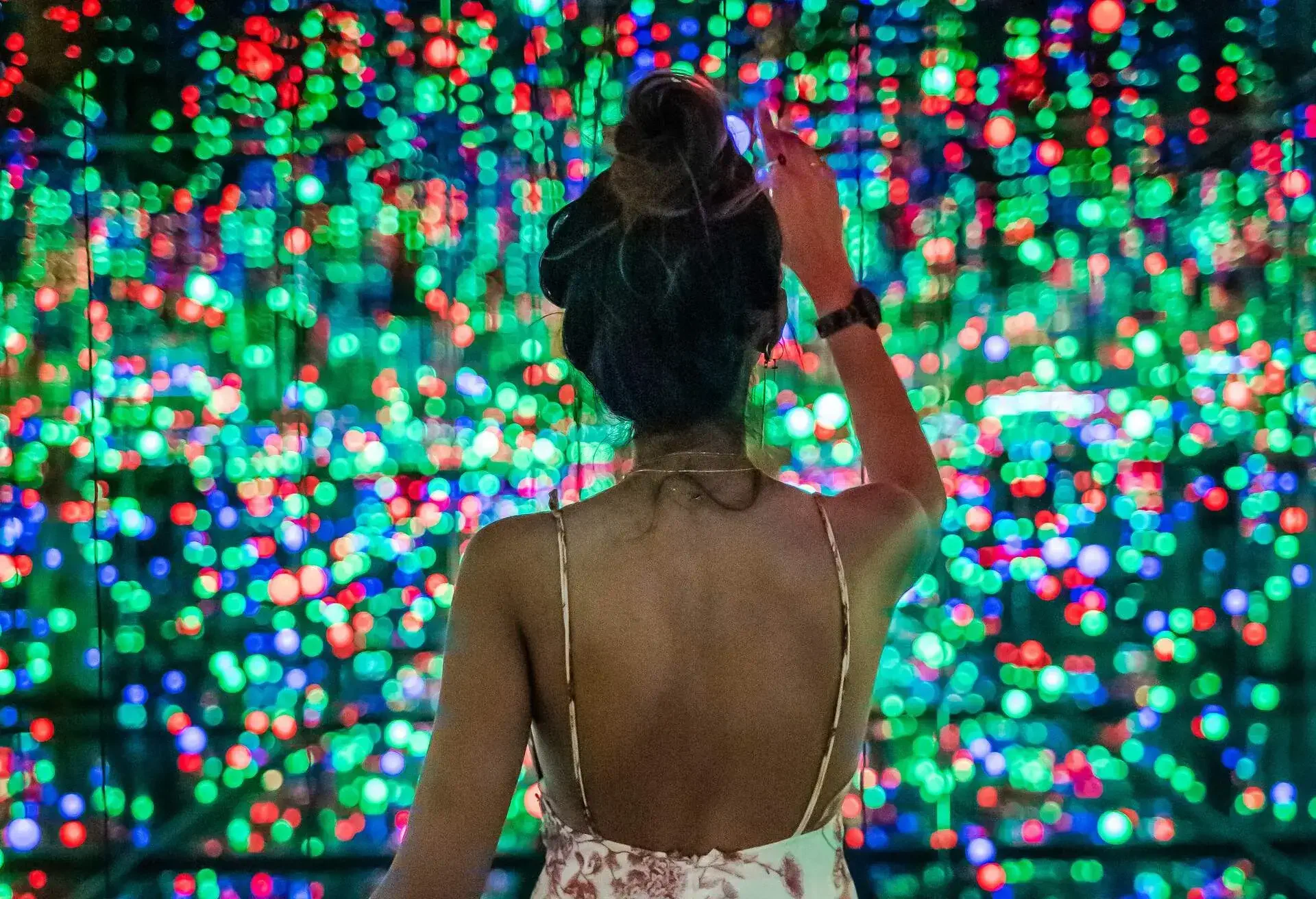
The island of Naoshima, in the Kagawa Prefecture, is home to around 3,000 residents, lovely beaches and an array of quirky contemporary art installations. With the aim of combining art, architecture and natural landscapes, the Benesse Art site began with the opening of the Benesse House Museum in 1992. Part modern-art museum, part resort hotel, the Benesse House Museum is home to a range of unique artworks in its rooms and throughout its grounds. One of its most iconic features is a giant pumpkin that sits at the end of a pier, gazing out at the horizon over the Seto Inland Sea.
Beautiful places closer to home
If a trip to Japan isn’t on the cards right now and you’re looking for picturesque sites a little closer to home, don’t worry; we’ve got guides to help you out. Why not head to Spain and visit one, or more, of the 20 most beautiful places in Spain. From the hiking trails of Tenerife to the historic monuments of Majorca, Spain has beauty for every traveller. Alternatively, lace up your hiking boots and get ready to explore some of the best natural attractions in the UK, such as Scafell Pike in the Lake District and Glencoe Valley in the Scottish Highlands.

